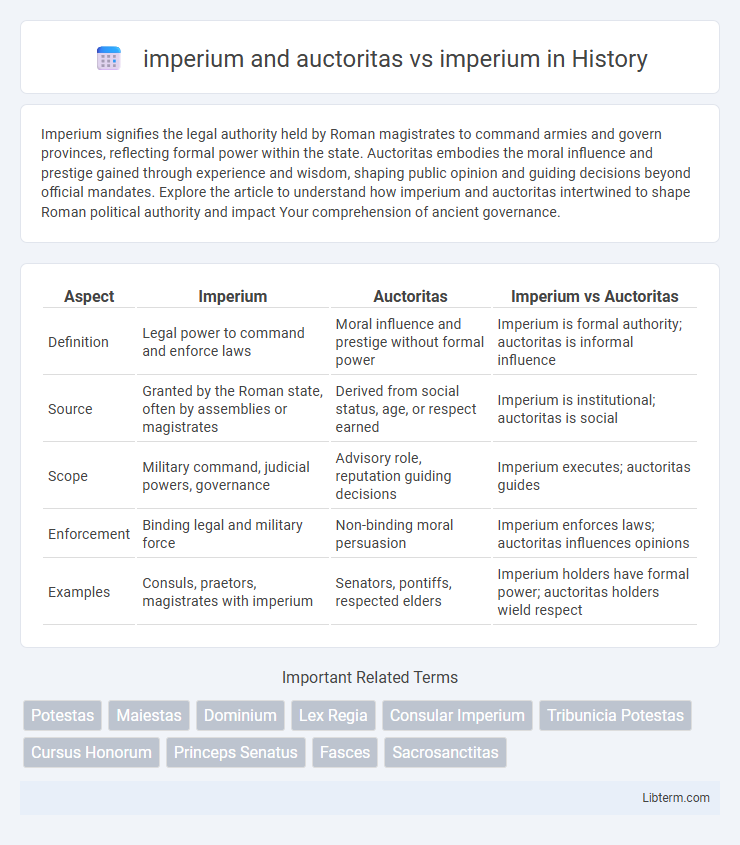Imperium signifies the legal authority held by Roman magistrates to command armies and govern provinces, reflecting formal power within the state. Auctoritas embodies the moral influence and prestige gained through experience and wisdom, shaping public opinion and guiding decisions beyond official mandates. Explore the article to understand how imperium and auctoritas intertwined to shape Roman political authority and impact Your comprehension of ancient governance.
Table of Comparison
| Aspect | Imperium | Auctoritas | Imperium vs Auctoritas |
|---|---|---|---|
| Definition | Legal power to command and enforce laws | Moral influence and prestige without formal power | Imperium is formal authority; auctoritas is informal influence |
| Source | Granted by the Roman state, often by assemblies or magistrates | Derived from social status, age, or respect earned | Imperium is institutional; auctoritas is social |
| Scope | Military command, judicial powers, governance | Advisory role, reputation guiding decisions | Imperium executes; auctoritas guides |
| Enforcement | Binding legal and military force | Non-binding moral persuasion | Imperium enforces laws; auctoritas influences opinions |
| Examples | Consuls, praetors, magistrates with imperium | Senators, pontiffs, respected elders | Imperium holders have formal power; auctoritas holders wield respect |
Defining Imperium: Origins and Meaning
Imperium, rooted in ancient Roman law, signifies supreme executive power vested in magistrates, encompassing military command and judicial authority essential for governance. Auctoritas, contrastingly, derives from social prestige and moral influence rather than formal legal power, shaping decisions through respect and persuasion within the Roman Republic. Understanding imperium's origins highlights its foundational role in state control and public order, distinguishing it from auctoritas's more subtle yet influential capacity.
The Concept of Auctoritas in Roman Society
Auctoritas in Roman society represented a form of moral authority and social influence distinct from imperium, which was the official power to command and enforce laws. While imperium granted legal and military control, auctoritas reflected a respected individual's recognized wisdom and ability to guide political decisions without coercive force. This nuanced difference underscored the importance of reputation and consensus in maintaining social order alongside formal authority.
Imperium vs. Auctoritas: Key Differences
Imperium refers to the legal and executive power held by Roman magistrates to command armies and enforce laws, whereas auctoritas represents moral authority and influence without direct coercive power. Imperium is a formal, institutionalized authority that enables decision-making and command, while auctoritas is recognized through respect, prestige, and social standing within Roman society. The key difference lies in imperium's tangible force and legal sanction compared to auctoritas's intangible and persuasive nature.
Historical Context: The Roman Republic
In the Roman Republic, imperium referred to the legal authority granted to magistrates to command armies and govern provinces, while auctoritas represented the moral influence and social prestige that guided political decisions. Imperium was a tangible power enabling enforcement of laws and military control, vested especially in consuls and praetors, whereas auctoritas was an intangible authority rooted in respect and tradition, often held by the Senate and elder statesmen. This distinction created a balance where imperium enforced decisions, but auctoritas shaped consensus and legitimacy in Roman governance.
Power Dynamics: Political and Social Implications
Imperium encompasses the legal authority to command and enforce laws in Roman governance, while auctoritas embodies the moral influence and social prestige that guide political decisions. The dynamic interplay between imperium and auctoritas shaped power structures, where magistrates exercised coercive control but relied on auctoritas to legitimize their rule and maintain social order. This duality influenced political alliances and social hierarchies, reinforcing authority not solely through force but through recognized respect within Roman society.
Case Studies: Notable Figures With Imperium and Auctoritas
Julius Caesar exemplifies the dual exercise of imperium and auctoritas, wielding military command alongside influential moral authority that shaped Roman politics and reforms. Augustus combined imperium with auctoritas, consolidating power as Rome's first emperor while maintaining Senate respect, which secured long-term stability and governance. Cicero demonstrates auctoritas without imperium, using his rhetorical skill and legal expertise to influence public opinion and Senate decisions during the late Republic.
Legal Authority: Functions and Limitations
Imperium represents the executive legal authority vested in magistrates to command and enforce laws, particularly in military and judicial contexts, while auctoritas signifies moral influence and prestige without direct coercive power. Imperium's functions include issuing orders, commanding troops, and administering justice, but its limitations arise from legal checks, such as the veto power of other magistrates and the temporality of offices. Auctoritas complements imperium by shaping public opinion and advising decisions, functioning as a stabilizing force within the Roman legal and political framework without overriding established imperium.
Cultural Impact: The Legacy of Imperium and Auctoritas
Imperium and auctoritas shaped Roman political culture, where imperium denoted formal authority to command and enforce laws, while auctoritas embodied moral influence and respected social standing. This duality influenced governance throughout history, with imperium reflecting legal power and auctoritas inspiring leadership legitimacy beyond mere coercion. Their legacy endures in modern concepts of political authority, blending statutory power with ethical influence in Western legal and political systems.
Modern Interpretations: Influence on Governance
Imperium continues to symbolize formal authority and command within modern governance frameworks, reflecting centralized power structures rooted in ancient Roman law. Auctoritas, representing moral influence and legitimacy, shapes contemporary political leadership by emphasizing consent and public trust beyond mere legal control. The balance between imperium and auctoritas informs modern debates on the scope of executive power versus democratic accountability in state governance.
Conclusion: The Enduring Relevance of Roman Authority
Imperium and auctoritas together defined the complex framework of Roman authority, with imperium representing formal executive power and auctoritas reflecting moral influence and social prestige. Understanding their interplay highlights the nuanced balance between legal command and respected counsel that sustained Roman governance. This duality remains relevant today as a model for blending authoritative leadership with ethical legitimacy in modern political systems.
imperium and auctoritas Infographic

 libterm.com
libterm.com